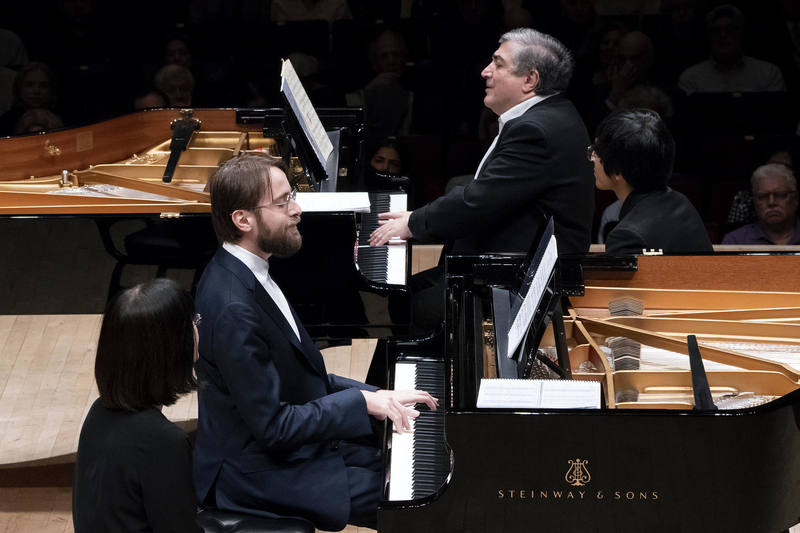176 keys makes for beautiful musical friendship at Carnegie Hall

It used to be that when musicians became star concert artists, they omitted all mention of their teachers from their program biographies.
Now they go on tour with them. Wednesday night, the widely acclaimed 28-year-old pianist Daniil Trifonov arrived in Carnegie Hall with the man he calls his mentor, Sergei Babayan, for a dazzling evening of music for two pianos.
Babayan—formerly a pupil of Gyorgy Saradjev and Mikhail Pletnev, it says here—has enjoyed a prestigious international career himself, if nothing like the skyrocket his young friend has been riding lately. In the two-piano medium , with its anything-you-can-do-I-can-do-better ethos, the Armenian-born pianist showed on Wednesday that he could match his brilliant protégé blistering scale for blistering scale.
Solo pianists pride themselves on creating the illusion that the piano is not a percussion instrument, but a sort of orchestra in a box, with singers. For some reason, however—perhaps out of the players’ concern to stay exactly together–a two-piano performance is often a clattery affair, with those hard felt-covered hammers leading the charge.
Wednesday’s concert did not entirely escape this syndrome, but it also offered many moments of lovely, fluid music-making, perhaps especially in the opening number, Schumann’s Andante and Variations in B-flat major, WoO 10.
Originally for a mellow-toned ensemble of two pianos, two cellos and horn, Schumann’s piece began and ended in his characteristic mood of pensive lyricism, but in the middle it took flight in finger-twisting figurations, blithely delivered by the two virtuosi.
For all its fast passagework, the piece never lost its feeling of intimate music-making. (In fact, a listener near the rear of the hall had to strain a bit to hear the murmur of the lidless pianos onstage.) The young star literally took a back seat to his mentor all evening, playing the Piano II part slightly upstage from Babayan’s stool. (The pianos faced opposite directions, with their keyboards aligned, so the players could watch each other out of the corner of an eye.)
In making the two-piano arrangement, Schumann had dropped some variations from the original version. Babayan arranged and restored three of these, which were interesting to hear, but one understood why the composer had decided they were a bit much for this slender piece.
Audibility was not a problem in Prokofiev’s massive score for the ballet Romeo and Juliet, as arranged by Babayan in 12 excerpts, ending with the starkly dramatic, clanging chords of the “Death of Tybalt” section. The players favored speedy tempos—faster than anyone could dance to, most likely—which were quite breathtaking when rhythm and articulation stayed accurate (which they didn’t quite do in a helter-skelter “Dance of Five Couples”).
The light-as-air illusion of ballet was reflected in Babayan’s arrangements, which featured plenty of ingenious interplay between the instruments and deft, well-phrased leggiero playing. But Prokofiev loved those hammers too, and Trifonov swung big ones in his thumping accompaniment to the “Dance of the Knights.”
The extraordinary “presence” of Trifonov’s tone, even in soft passages, sets him apart from other pianists, including his distinguished friend Babayan. Their work together on Wednesday was in the main collegial and well-matched, but occasionally one couldn’t help noticing something special going on in Piano II, even in accompaniment figures.
Rachmaninoff’s Symphonic Dances, Op. 45, offered the program’s meatiest music. The great pianist’s two-piano version of his orchestral masterpiece was, as one might expect, a pianistic feast, served on Wednesday with heart and imagination. The ironic three-note motive of the opening pages flashed through the slightly macabre turbulence like streaks of lightning. The nostalgic saxophone tune sounded feeble at first, but Babayan made it soar by the end.
The dark, halting waltz movement was distinguished by shapely phrasing and expert voicing of this composer’s thick chords and complex textures. The fiery finale was treated more like a Presto than the marked Vivace, but it was a thrill to watch the two players feeding off each other’s energy, the older pianist relatively cool in front, the younger one behind him lunging at the keys and bouncing off the bench.
Percussionist Gabriel Globus-Hoenich then joined the two pianists, adding enhancements of his own devising to Ravel’s two-piano version of the Rapsodie espagnole for orchestra. Trifonov’s soft four-note ostinato glowed under Babayan’s lush phrases in the opening “Prélude à la nuit,” and the three players wove a tissue of dance dreams in “Malagueña” and “Habanera.” Fast, brilliant interplay, Babayan singing high and dreamy in an interlude, and a hot coda told the story in “Feria.”
The discreet, orchestral-style contributions by percussionist Globus-Hoenich—with bass drum, timpani, tambourine, cymbal etc., and of course castanets—sounded both tasteful and unnecessary. The pianos were already percussion instruments, capable of evoking all sorts of sounds, and had been doing so for an hour and a half. Adding more instruments to them, however finely played, felt like a bit of an intrusion on a charmed two-piano world.
The first encore brought Trifonov at last to Piano I, as the duo pumped out staccato and singing themes to an inexorable beat in “Idée fixe” from Prokofiev’s score for a never-made film, The Queen of Spades.
A true “encore,” a repeat of Ravel’s brilliant “Feria,” closed out the evening.
Carnegie Hall presents the Orchestra of St. Luke’s, Bernard Labadie conducting, with pianist Beatrice Rana, in works by Bach and Mendelssohn, 8 p.m. Thursday. carnegiehall.org; 212-247-7800.